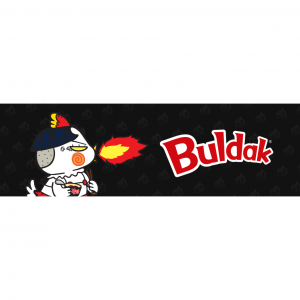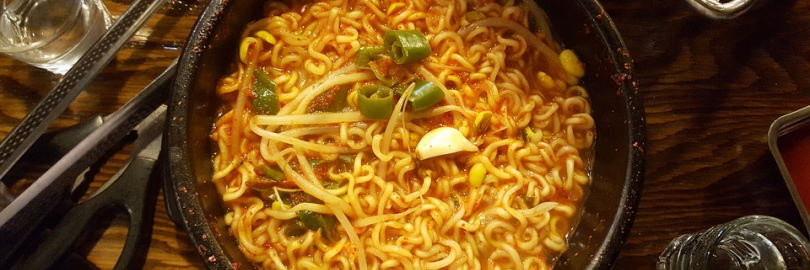
Top 15 Most Famous Korean Ramen Noodles You Must Try in 2025 (Nongshim, Samyang, Ottogi, Paldo)
When we think of Asian-inspired instant noodles, you probably picture them coming from China or Japan. After all, Japanese ramen is arguably the most famous Japanese dish. While this may be true, have you ever heard of Korean ramen? Consumption of Korean ramen has grown dramatically worldwide in recent years. What is Korean Ramen? Known as Ramyun or Ramyeon in Korea, Samyang Ramen has been a favorite instant noodle among Koreans since it first hit the market in 1963. With Korean dramas becoming more and more popular, often showcasing the best Korean ramen noodles, many top brands have become bestsellers in the western world.The list below describes the 15 most popular Korean instant noodle & ramen brands and flavors available to anyone in the world. There is no doubt about the popularity of ramen, but there are many old and new brands in the market. Here's our quick ranking of ramen brands, which takes price, quality, taste, opinion, and nutritional value into account. We also have the most spicy noodles in Korea, several sites to buy Asian food, and the difference between Korean ramen and Japanese ramen.
What is ramen and where did it come from?
Ramen is a type of noodle that was originally from China. It is called "Lamian" in Chinese. Lamian/Ramen, therefore, is literally translated as hand-pulled noodles.
It was brought to Japan in the early 20th century by Chinese people who studied in Japan and has since become one of the most popular dishes in Asia. Ramen noodles are made from wheat flour, water, and salt. They are usually served in a broth, with various toppings such as meats, vegetables, and eggs.
Instant ramen is a type of ramen noodle that is precooked and then dried so that it can be stored for a long period without going bad.
Ramyeon is the Korean version of instant Japanese ramen. Ramyeon was invented by Korean businessman Jean Jong-Yeon, who discovered instant ramen while visiting Japan in the 1960s. Utilizing the same flash-fry method, Jong-Yeon created ramyeon (also spelled ramyun), packages of curly, quick-cooking noodles with a spicy soup packet and dried vegetables. As was the case with the invention of ramen, ramyeon was devised as a means to feed people quickly and cheaply after the Korean war. The original instant soup packets were sold for one cent.
In South Korea, ramen noodles are considered to be staple as well as a gourmet delicacy. Just like several other countries, Korea has added its touch of native originality to ramen over the years. It is available in a variety of flavors like kimchi, cheese, seafood, beef, and chicken.
Ramyeon, Ramen, or Ramyun
Ramyeon or Ramyun is '라면' in Korean and Ramen is 'ラーメン' in Japanese.
Ramyun means "noodles in spicy broth" and it's clear the dish is adored; the average Korean consumes 80 to 90 packets per year, turning ramyeon into a $1-billion-a-year industry. Ramyeon is considered Korean comfort food and, unlike its Japanese counterpart, the curly noodle soup is a lot spicier.
Just in 2025, South Korea's instant noodle exports hit a new high in the first half of the year. Yet the country’s leaders in the industry differ on how to spell the product in English.
Nongshim, the perennial industry leader of instant noodles in the country, spells it “ramyun” on its homepage and on its exported product packages. But Ottogi and Samyang inscribe “ramen” on products that are shipped overseas.
When inquired about which of the two was the correct spelling, the National Institute of Korean Language gave a different spelling. “In accordance with the ‘Orthography of Romanization of Korean language,’ it is to be written as ‘ramyeon,’” the NIKL said.
Ramen, ramyeon or ramyun – one may ask: Why does it even matter?
It does because to many Koreans, ramen and ramyeon are two different dishes.
Ramen is one of Japan's most famous delicacies, with a history dating back more than a century.
Japanese author Hayamizu Kenro in his book "Ramento Aikoku" details how soba, a noodle originating in China, was brought to Japan during the Meiji period (1868-1912). "Soba noodles" then became popular during the economically difficult times following the defeat in World War II and during the massive distribution of wheat by the United States to East Asia.
The world of ramen itself is widely believed to have come from the Chinese term "lamian", which means to pull or extend (la) noodles (mian).
In 1958, Taiwan-born Japanese inventor and businessman Momofuku Ando released the first-ever instant noodles, Nissin Chikin Ramen, which quickly gained popularity. Five years later, Korea’s Samyang Group -- through cooperation with another Japanese instant noodles company -- released the first version of Samyang ramyeon in Korea, which is still in use today.
Although ramen and ramyeon share the same roots, Koreans have very different perceptions of the two. In Korea, ramen almost exclusively refers to Japanese noodles made with fresh ingredients and spices, usually served in restaurants. Meanwhile, ramyeon refers to instant noodles made with dried vegetables and artificial seasonings. Ramyeon is served at eateries, too, but cooks use pre-packaged instant noodles.
While Koreans see ramen as a completely different concept from ramyeon, there are few outside of Korea -- especially Westerners -- who make such distinctions.
Clearly Korean ramyeon is quite distinctive and very different from Japanese ramen. That said, some companies have opted to spell their English names with ‘ramen’, ‘ramyeon’, or ‘ramyun’ because they get lumped together as ‘ramen’ abroad quite often. In articles published this year of recommended Korean dishes, the Los Angeles Times -- based in the city with the biggest Korean community in America – also used the term “Korean ramen.”
Whether called ramen or ramyeon, the popularity of Korean instant noodles remains on the rise, perhaps buoyed by the booming success of Korean pop culture content like “Parasite.”
The top consumers of Korean instant noodles were China and the US, followed by – ironically enough -- Japan.
What is the difference between instant noodles in Japan and Korea?
Internationally, instant noodles from Japan and Korea are usually called ramen. What is the biggest difference between them?
Japanese instant noodles tend to have a milder taste than Korean instant noodles, such as the most popular tonkotsu ramen or miso ramen. However, the soup base of Korean instant noodles usually contains spice ingredients. This can be in the form of chili paste or just some ground pepper added to ramen noodles.
Also, another thing that should be noted is how Korean ramen broth is made with processed ingredients like kimchi, gochujang, black bean paste, etc. Alternatively, ingredients such as pork and beef bones, vegetables or seafood are often used in Japanese ramen soup bases to create a thicker broth.
Generally, if you want something light, go for Japanese instant noodles. If you're craving something a little more exciting, Korean instant noodles will be your best bet!
Best Ramen Brands of Korean Ramyeon Instant Noodles, Ranked
Do you know which are the most delicious top Korean ramen brands in the world? The following is the latest list of the most popular Korean instant noodle brands:
Nongshim
Samyang Foods
Ottogi
Paldo
Pulmuone
Nongshim ramen is sold in over 100 countries globally and plays a lead role in K-ramen obsession, followed closely by Ottogi, Samyang, and Paldo ramen brands.
Great place to buy delicious Korean ramen
Next, we will recommend some good Korean local instant noodle series. These ramen noodles are made in Korea and can now be easily purchased through some international e-commerce sites. So, where to buy authentic Korean instant noodles?
Some good sites to get the best Korean instant noodles (or other Asian foods) are:
Walmart.com
: Get Up To 4% Cash Back
Costco
: Get Up To $4 Cash Back
StyleKorean.com: Get Up To 6% Cash Back
Amazon.com
Yami
Yummy Bazaar
: Save 5% on your 1st order
Asian Food Grocer
Top 15 Best-Tasting & Best-Selling Korean Ramyeon (Ramen)
to Moisten Your Appetite
#1. Nongshim’s Shin Ramyun
($16.98 AT Sam's Club - Get Up To 4% Cash Back)

Nongshim’s Shin Ramyun products (Nongshim)
To begin this list we are going to start with perhaps the most famous Korean ramyun on the market – Shin Ramyun. Due to its fame, it’s also very easy to pick up almost anywhere in the world.
Nongshim occupies a significant share of the Korean instant noodle industry, and its brand leader, SHIN Ramyun, has sold over 1 billion packets globally since its launch! Isn’t it surprising?
Nongshim's former chairman, Shin Choon-ho, founded Nongshim in 1965 and made it the country's top instant noodle and snack maker.
Under his leadership, Nongshim has rolled out a number of signature items that have been popular both at home and abroad.
Since the first overseas shipment to Los Angeles in 1971, the flagship product of Nongshim has expanded its global reach gradually.
The company has built three factories in China and one in LA to support overseas sales from the late 90s to early 2000s. It also opened two sales subsidiaries -- one in Japan and another in Australia -- to further push international sales of the product.
Shin Ramyun was one of the first Korean food products sold in the American discount retail chain Walmart. It is currently sold in more than 100 countries across the globe.
Its flagship products include Shin Ramyun, a spicy brand; Chapaghetti, instant black bean noodles; and Neoguri, spicy udon-like noodles. Chapaguri, which is a signature noodle dish from the Oscar-winning film "Parasite," is a mixture of Chapaghetti and Neoguri.
Let’s start with the signature Shin Ramyun, probably because its beef broth base is uncommon in ramen.
Shin ramyun has a bit of spice, but it is far from one of the spiciest ramyuns on this list. However, if you are very sensitive to spice or are not used to Korean ramyun, this can feel quite spicy.
It comes in instantly recognizable red shiny packaging and claims it "can make a grown man cry".
Interestingly, the spiciness will clear your sinuses and any bad mood from a hard day at work, while the chewy noodles will perk you up.
The chewiness of the noodles and the richness of the spicy broth – packed with beef, mushrooms, carrots, and peppers – will make you crave another bowl instantly. Shin Ramen has 3 different versions; Shin Meal Noodle, Shin Cup Noodle, and Shin Ramen Bowl.
#2. Nongshim Shin Ramyun Black
($21.97 AT eBay - Get Up To 5% Cash Back)

There are actually two options for Shin ramyun; the well-known red and the "premium" black.
If you're looking for a better flavor, check out Shin Ramyun Black. The Shin Black noodles are a premium version of NongShim’s popular Shin Ramyun noodles, and they contain an additional “sul-long-tang” (ox bone) seasoning packet. The milky bone broth facsimile makes Shin Black’s soup creamier and less spicy than the original Shin Ramyun.
It’s also significantly more expensive, costing 50% more in Korea.
If you're trying it for the first time, go for the Red Classic, but there's no doubt that the best Korean ramen is the Shin Black Premium, as they're more satisfying, tastier, and more fun than regular ramen.
It has a winning combination of a complex, spicy broth, substantial dehydrated vegetables, and toothsome noodles.
Shin Black Ramen comes in three different versions; Shin Black Meal Noodle, Shin Black Cup Noodle, and Shin Black Ramen Bowl.
#3. Korean Buldak Stir-Fried Ramen
($6.88 AT Walmart - Get Up To 4% Cash Back)
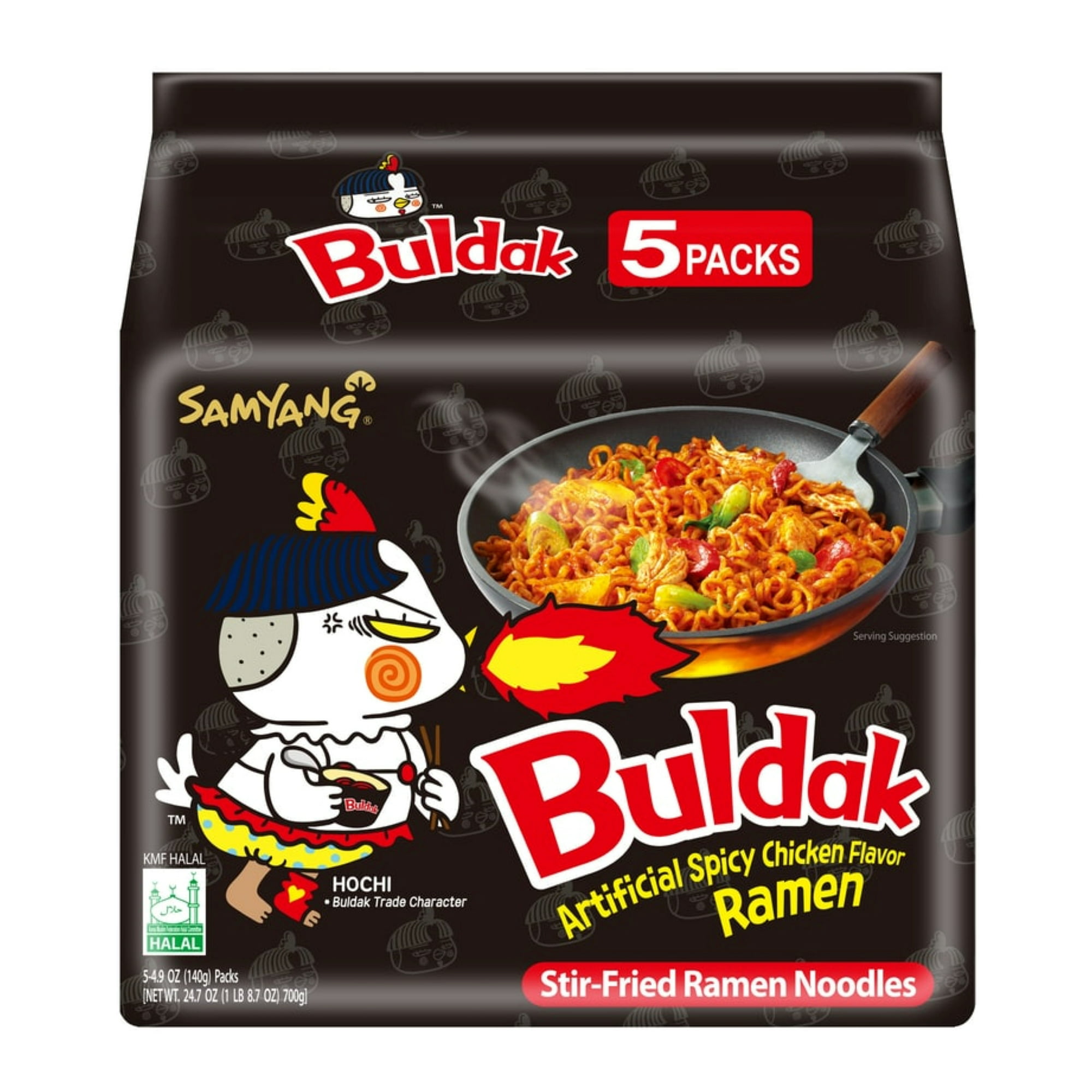
Samyang Foods was South Korea’s first instant ramen noodle maker.
Samyang's delicious Buldak Stir-Fried Hot Chicken Flavor Ramen is considered one of the spiciest instant noodles in Korea. If you're a fan of spicy food, it's definitely a must-try.
Korean food maker Samyang Foods Co., which was first to introduce Korean style instant noodle ramyeon in 1963, is enjoying a new heyday with Buldak, spicy chicken favor recipe creating an addictive phenomenon in Korea and beyond.
Samyang Foods' Hot Chicken Flavor Ramen, or Buldak-bokeum-myeon, has passed the cumulative sales milestone of 4 billion. One in two people around the world ate the spicy instant noodle once.
Buldak Spicy Chicken Ramen products are currently sold globally including in the US, Europe, Australia and Southeast Asia. Some notable Samyang ramen products include its kimchi ramen, potato ramen and its spicy Buldak ramen range.Samyang launched the spicy instant noodle product in April 2012.
Including the original flavor inspired by a Korean spicy stir-fried chicken dish, there are nine different flavors in the lineup, including creamy Carbo Hot Chicken and Chinese food-inspired varieties.
The hot stir-fried instant noodle was launched in 2012 and became famous through the Fire Noodle Challenge. The company introduced various versions, including Carbo Buldak Noodles and Jajang Buldak Noodles. The product reached 100 million cumulative sales in 2014, 1 billion in 2017, 2 billion in 2019, and 3 billion in 2021. It reached four billion in one year after achieving three billion.
Buldak-bokkeum-myeon is not a soup-based ramyun, and rather should be eaten with no water. They are spicy noodles that only a few people eat out of enjoyment – most people eat them only as a dare or challenge.
Definitely not for the faint-hearted, South Korea’s Samyang Buldak Spicy Noodle products take you on a tongue-numbing and sweat-inducing experience that’s definitely worth the try, especially in the company of friends who want to literally spice up their usual instant meals.
This stir-fried ramen is extremely spicy, even by Korean ramen standards, but also has a delicious and addictive flavor with chewy and firm noodles. The sauce is flavorful, creating the perfect balance between spiciness and a strong chicken flavor.
You’ll love it if you like that taste of a volcano in your mouth.
Samyang Buldak has two options; you can get the standard spicy option or the Samyang 2X Spicy Hot Chicken Flavor.
With the product well-received abroad, Samyang Foods plans to continue to focus on global customers.
It plans to develop more Buldak Ramen flavors for foreign markets. They will only be available in certain countries.

Buldak Ramen flavors sold by Samyang Foods. [SAMYANG FOODS]
Buldak ramen has 11 flavors: Hot Chicken, Original, Carbo, Kimchi, Light, Spaghetti, Jjajang, Stew, Curry, 2X(HEAK), Cheese, and Corn. It also comes in 3 cup noodle flavors, Orignal, Carbo, and Cheese.
#4. Samyang 2X Spicy Hot Chicken Flavor Ramen
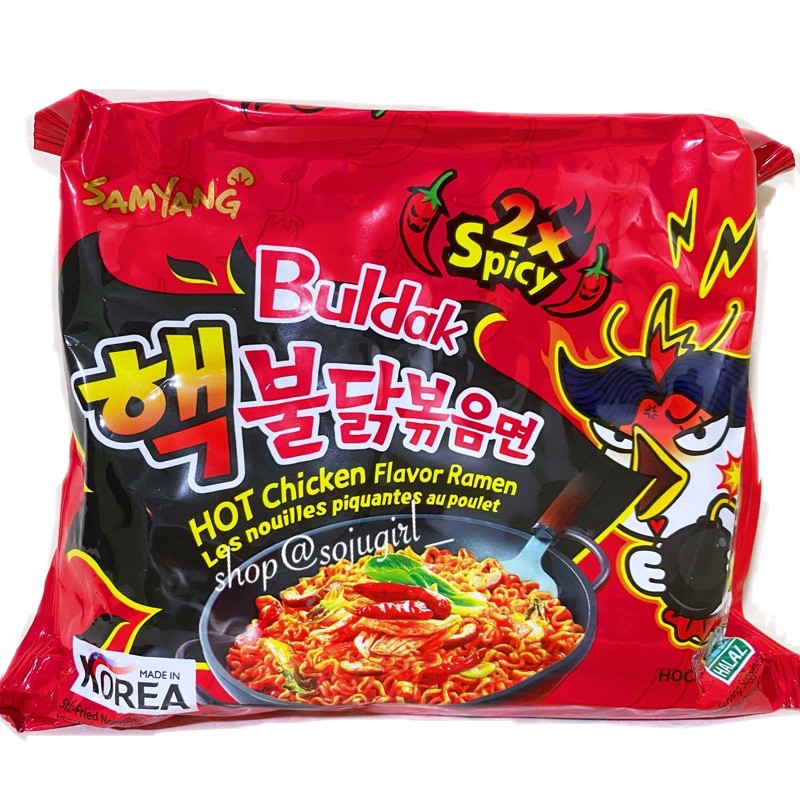
Some of you may not know that Samyang 2x Haek Buldak Spicy Chicken Ramen is just a limited edition to celebrate the year of the Fire Rooster in January 2017.
The name “haek” roughly translates to “nuclear” or “very extreme”, while "buldak" means "fire chicken". Despite selling 8 million packets in Korean market, it was discontinued after 4 months.
But the hot noodle brand quickly returned to the Asian grocery market online and in brick-and-mortar stores due to high demand.
The renewed Haek Buldak Spicy Chicken Ramen, also known as 2X Fire Noodle to non-Korean speakers, will have an increased Scoville Heat Units of 10,000. The renewal added approximately 2,000 Scoville Units to the original 8,706, making the 2X Fire Noodle the spiciest ramen in Korea and possibly in the world.
This may not be for the faint of heart, it is definitely a challenge to complete. However, the burn is well worth the experience, the sweat, and the memories with friends!
Here's a Samyang Spicy Buldak Ramen compares vs other Samyang flavors comparison based on heat level:
Samyang 2x Spicy Hot Chicken Flavor Ramen- 8,808 SHU (original) / 10,000 SHU (2018 re-release)
Samyang Original Hot Chicken Flavor Ramen- 4,404 SHU
Samyang Hot Chicken Flavor Ramen Curry - 3,810 SHU
Samyang Hot Chicken Carbo Flavor Ramen- 2,400 SHU
Samyang Hot Chicken Flavor Ramen Cheese - 2,323 SHU
Samyang Hot Chicken Flavor Ramen Jjajang– 1920 SHU
#5. Samyang Buldak Carbo Korean Spicy Hot Chicken Stir-Fried Noodles

The pink packaging of Samyang Buldak Carbo-Flavored Stir-Fried Ramen is enough to catch your eye, but when you read carefully what the “carbo” flavor means, you will be surprised to find that it actually stands for carbonara!
An instant fusion of carbonara and Korean ramen? Samyang Fire Hot Carbon Chicken Ramen makes it all possible!
What's even more surprising is that there is even a spicy taste! Their “carbo” sauce packet consists of a creamy rich mix of milk, cheese, and butter powders, along with seasonings that usually make up your traditional carbonara sauce.
The secret? Whipped cream.
Sweet but not candy-sweet cream is in the cheese powder for this, giving the noodles a mellow creaminess that the original cheese flavor was begging for. That sugary hit melds well with the traditional buldak sauce. These are slightly less spicy because of it.
It’s a surprisingly great complement to the fiery hotness of your favorite Samyang Hot Ramen recipe, so you can delight on a full serving without breaking too much of a sweat!
#6. Ottogi Jin Ramen (오뚜기 진라면)
Jin Ramen is one of the oldest instant noodle brands in South Korea. The classic ramen taste launched in 1988 and has a deep and thick broth that has captivated Korean palates with two flavors: “mild” and “spicy.”
However, despite being very popular within the country, it hasn’t yet achieved the very large levels of fame that Shin Ramyun has.
Jin Ramyun tastes quite similar to Shin Ramyun as it is also beef-based (although, it has a less strong beef flavour). On top of this, Jin Ramyun has a stronger kimchi/pepper taste as opposed to Shin Ramyun which relies more on the beef taste.
It has a mild level of spice and it is great for lunch, dinner or just a quick snack! In general, most people agree that Jin Ramen is relatively more mild than other ramyeon brands so it’s a good option for those that aren’t used to the spice and want an introduction.
Also worth mentioning is that the ramyun noodles themselves are firm and stay at the perfect consistency long enough to finish eating.
The noodles are also firm and smooth and don’t become mushy quickly.
Want to buy Jin Ramen online? The Korean-style instant noodles are now available to buy online on Amazon, in a blue-packaged mild version and a red-packaged spicy version. Both versions include the noodles, vegetable packets and ramen broth packets.
Jin Ramen Mild is very popular with those who don’t appreciate the spiciness of Shin Ramen, making it the number one ramen for Korean children.
Those who enjoy more lasting heat can go for the spicy variant but Jin is still less spicy compared to other ramyeons like Shin and another Ottogi product, Yeul Ramen.

#7. Ottogi Cheese Ramen

Different from most spicy Korean ramen, this ramen is for people who love the creamy taste. The cheese flavor is also not overwhelming. Cheese Ramen has hints of spice to it, and even people who don’t enjoy spicy foods can handle this.
Launched in 2010, ‘Soft Cheese Ramen’ with plenty of cheese is ramen that you can enjoy soft and savory by sprinkling savory cheese in a spicy soup. Because cheese is a powder soup, not a slice, you can enjoy it according to your taste.
A pack of Ottogi’s Cheese Ramen includes springy, chewy noodles. The soup mix contains no meat and Ottogi claims that this ramyeon is vegetarian-friendly. But it does contain gluten and soy.
Powdered cheese, sweet corn, ham, spinach, cabbage, carrots, and other rich ingredients are added to give you the unique taste of cheese ramen. It is being sold overseas, not domestically.
Young children or people who can't tolerate spicy food can enjoy this savory Cheese Ramen. If you want a little more special flavor, add just a little curry powder to your meal.
#8. Paldo Kokomen Spicy Chicken Flavor Ramen

KoKoMen (KoKo meaning ''cock-a-doodle-do,'' the sound a rooster makes, in Korean) is a chicken soup based Korean instant noodle.
Paldo’s Kokomen is probably the closest thing to a chicken noodle soup. The flavoring packet even includes small pieces of shredded chicken, green onion, seaweed, and chili.
This ramyun is a little bit spicy (the packaging says ‘clear and spicy), however, I found it to still be less spicy than Shin and Jin Red Ramyun.
Paldo Kokomen is distinctly different from the other ramyuns on this list in that it has a ‘light’ chicken taste. If you are looking for a ramyun with a lighter, less spicy, or chicken taste, then Kokomen is a great choice.
Even though it is an instant noodle, it still has the chewy noodles with authentic broth, which makes this instant bowl ramen spicy chicken flavor extra popular. The noodles are perfectly soft and chewy, too but not mushy.
#9. Nongshim Chapagetti Chajang Noodle

Not just Shin Ramyun, but Korean ramen products as a whole are enjoying popularity overseas, helped by the COVID-19 pandemic and the success of Oscar-winning film “Parasite” which featured a combination of two ramen brands, called “jjapaguri.”
If you watched the Korean movie ‘Parasite’, then you probably recognize this one as it is one half of the Chapaguri/Jjapaguri recipe from the movie.
Chapagetti is from the words Chajang (Jajang) and Spaghetti. You can tell from the name that it is a blend of Chinese (fried black soybean sauce) and Italian(spaghetti noodles) flavors. The vegetable flakes have chunks of dried potato, onion, and carrots to go with its delicious jajang sauce powder and olive oil.
It is also a ‘dry’ ramyeon or no-broth ramyeon. Chapagetti comes in 2 versions; Chapagetti, and Chapagetti Big Bowl.
#10. Nongshim Neoguri Spicy Seafood with Udon-Style Noodle

This is the other half of that recipe from the movie ‘Parasite’, Chapaguri/Jjapaguri. Debuted in 1982, Neoguri became popular specifically because of the thick udon-style noodles and a distinctive spicy seafood flavor.
If you’re looking for a thicker noodle option, this is the one you need to try. Neoguri has got famous thanks to the Oscar-winning movie, “Parasite.” In the movie, it was called “Ramdon,” which means a mixture of ramyeon and udon.
This one also comes in two options – a spicy seafood and a mild seafood.
It has a fragrant broth that’s full of seafood and seaweed flavours. The Nongshim Neoguri’s rich soup broth is further enhanced by the dried seaweed and thick piece of kombu. We especially love how there are pieces of fishcake in the Nongshim Neoguri.
It’s no wonder that this is one of the best Korean instant noodles of 2025! This was an instant hit in Korea and became Korea’s favorite instant seafood noodle soup.
This has 2 versions; Neoguri, and Neoguri Cup Noodle.
#11. Nongshim’s New SHIN Stir Fry Ramyun

Nongshim recently launched Stir-fried Shin Ramyun to commemorate the 35th anniversary of the launch of Shin Ramyun. Shin Ramyun, which was launched back in 1986, is undoubtedly one of the most popular Korean ramyun brands worldwide.
The newest Stir-fried Shin Ramyun is the first soupless product from the line of Shin Ramyun products. It comes in two different forms, a big-sized cup noodle as well as individually packaged noodles for cooking.
It is notable to mention that Nongshim’s stir-fry noodles have thick, smooth, and springy noodles.This soupless noodles are showcasing Nongshim's signature smooth noodles, firm and chewy, tossed in a special seasoning oil with a sweet and spicy taste that hits the spot!
Complete with shiitake mushrooms and cute little coin-shaped fish cakes stamped with the “辛” (meaning: spicy, hot) icon of Shin Ramyun, the halal Shin Stir Fry might be everyone's next favourite fried noodles!
It seeks to produce an explosion in the mouth with its spicy and unique blend of chilies, scallions, and special seasoning oil. The noodles are relatively spicy, maybe even more than the usual soup version.
The cooking time is also significantly reduced, with the cup noodles only requiring 2 minutes, while the packet noodles requiring only 3 minutes. The usual Shin Ramyun takes around 4 to 5 mins in comparison.
To add, it is halal-certified and available in a pack of five with dark red packaging and the Made in Korea logo.
This convenience and spicy treat are ideal for any time of the day to accompany every tiny moment, especially when those late-night cravings strike.
#12. Samyang Ramen Korean Noodle Soup

Released in 1963, this was the first original mild soup with chewy ramyeon. Even decades after its first appearance, it is still among the most sought after ramyun in Korea and is the most iconic ramyun in Korea that keeps the originality of the Korean soul food.
Though not the spiciest, it is nostalgic for many people. If you want to start with the original, start here and then try the rest. The broth of this one has a nice beef taste if you like that base.
With ham flakes added, the soup has a deep flavor and rich taste which makes it easy to enjoy for everyone regardless of age or gender. It is perfect for the whole family to relish together.
Adding potato starch enhances the chewy textures of noodles and allows for a richer meal.
Samyang Ramyun comes in 2 flavors, original and spicy.
#13. Nongshim Kimchi Spicy Red Chili Ramyun

These noodles contain kimchi, a globally popular fermented dish that’s nutritious and makes a great addition to many foods. With this added kimchi taste, and a mild spiciness, this ramen bowl is well-balanced and flavorful – perfect for those who are newbies to kimchi.
These are the best Korean instant noodles of 2025 thanks to the accompanying dehydrated kimchi flakes. The kimchi flakes are still sour, so you’ll get a truly authentic kimchi flavour with these Nongshim Korean Kimchi Noodles!
#14. Paldo Bibimmen
If you liked Korea’s world-renowned “bibimbap,” how about trying Paldo’s “bibim noodle”?
It is a product that has the highest share in the Korean bibim ramen market. This Korean ramen was inspired by Korean cold spicy noodles. The perfect balance between spicy, sweet, and sour flavors makes Bibimmen so unique.
Paldo has been dominating the market for the past 38 years, since the launch of its best-selling "Paldo Bibimmeyon" in 1984. It once enjoyed a market share of over 60 percent, but the latecomers have introduced similar instant noodles with a sweet and spicy sauce that brought the figure down to the 50-percent range.
The all-time leader in the category is Paldo’s Bibim Men, inspired by the spicy noodle dish bibim-guksu made with thin plain noodles.
Ottogi’s “Jinjja Jjolmyeon,” released in 2018, is a strong competitor. Jinjja means “real” in Korean, while jjolmyeon is a dish of thick, chewy wheat noodles with spicy sauce and vegetables.
Whereas Bibim Men’s noodles are slimmer than conventional ramyeon, Jinjja Jjolmyeon’s potato starch-based noodles are thicker and chewier, similar to the original dish it is based on.
Pulmuone has also joined the battle with a jjolmyeon product: “TaengTaeng Bibim Jjolmyeon.” Also released in 2018, the product boasts that it uses noodles that are not fried and therefore have lower calories and fat.
Samyang Foods added a Chinese twist to bibim-guksu. Its “Joonghwa Bibimmyeon,” for which joonghwa stands for Chinese-style in Korean, contain onions, oyster sauce and chili oil - all frequent ingredients in Chinese dishes.
Another Korean dish that has taken a slice of the cold ramyeon market is makguksu. The dish is made up of dark-colored buckwheat noodles with a spicy sauce.
Both Ottogi and Paldo have released ramyeon versions 2018. This is the first time that Paldo has rolled out a new summer instant noodle product since it released Bibim Men in 1984.
From top: Paldo’s Bibim Men and Paldo Makguksu Ramyeon, Ottogi’s Jinjja Jjolmyeon and Chuncheon Makguksu, Samyang Foods’ Joonghwa Bibimmyeon. [EACH COMPANY]
For decades, cold ramyeon has been overshadowed by its hot soupy brother. Indeed, for many consumers, ramyeon exclusively refers to the hot soup-based dish epitomized by Nongshim’s Shin Ramyun.
At 2,769 Scovilles, Paldo’s Bibim-men is one of the spiciest Korean instant noodles. But the spice is tolerable, especially since it’s also deliciously sweet. Paldo added apple concentrate to sweeten the sauce. Definitely an interesting ramyeon and does a great job at replicating the traditional bibim myeon.
Since its launch, it has maintained its unique blue wrapping paper. It has solidified its popularity due to the effect of boosting the appetite lost in the summer.
Bibim myeon does not need ice or refrigeration though. Like other instant Korean ramen brands, it still needs hot water. After boiling, you wash the noodles in cold water, drain them, then mix them with the sauce. The rinsing is not just a method to make the noodles cold but also a way to make them chewier and not clumpy or mushy.
Paldo Bibim Men is a delicious cold, brothless ramen noodle dish with sweet and spicy seasoning sauce to mix with the noodles. The sauce is sweet and spicy with a hint of apple.
#15. OTTOGI Yeul Ramen Noodles

Enjoy Ottogi Yeul Ramen if you love the spicy flavor of ramen noodles. Yeul Ramen resembles a warm hug—welcoming, comfortable, and just enough heat to keep you engaged.
This one’s my favorite among all the Korean instant noodles I’ve had and it’s such a shame that it’s not as famous as Shin, Buldak Bokkeummyeon, or Jin Ramyun.
Yeul means “fever” in the literal sense and at 5,013 Scovilles, and there isn’t a more appropriate way to describe excellent ramen than that of a fever. Similar to a fever, it gradually overtakes you until it’s too late, and you’re either dripping in sweat or fumbling to soothe the slow fire in the mouth.
Despite the soup having a small habanero flavor, the original amount of spice wasn’t too severe. It also doesn’t burn my mouth as Buldak Bokkeummyeon does, but it does leave a lasting heat.
It is a chicken that is paired with a very spicy sauce. Korean instant ramen that is extreme in taste perfect for Mukbang uses for "spicy challenge".
PREMIUM CHEWY NOODLES, lots of thick, chewy, soft noodles cooked in a rich red pepper broth, load with vegetable, red pepper , green onions, shiitake mushrooms, carrots and cabbage. The spicy and rich soup, and various vegetables enriches your meal.

Extrabux is an international cashback shopping site, offering up to 30% cashback from 10,000+ Stores!
Squarespace, SkinStore, MATCHESFASHION, The Wall Street Journal, NordVPN, Visible, Armani Exchange, Sam's Club, PUMA, AliExpress, Card Cash, NET-A-PORTER, Udacity, Udemy, Selfridges, LOOKFANTASTIC, Vimeo, Coach Outlet, lululemon, PrettyLittleThing, Booking.com, Ripley's Aquarium, iHerb, Groupon, etc.
Join to get $20 welcome bonus now! (How does Welcome Bonus work?)
Recommendation
-

Apple Watch Ultra 2 Real vs. Fake Guide 2025: How To Tell Original From Fake?
-

Microsoft 365 A1 vs. A3 vs. A5: Full Comparison & Verdict 2025
-

Is Turkish Airlines Good for International Flights?
-

Top & Best 12 Sneaker Apps/Websites for Raffles, Releases & Restocks in 2025
-
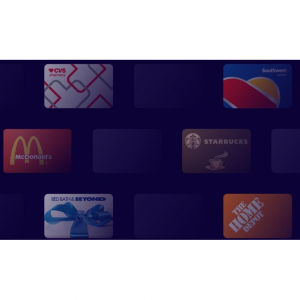
7 Best Gift Card Exchange Sites - Buy, Sell and Trade Discount Gift Card Safely and Instanly!


 사진 크게보기
사진 크게보기




